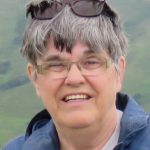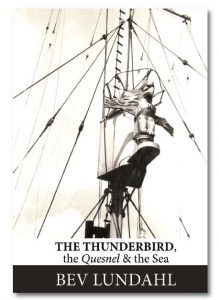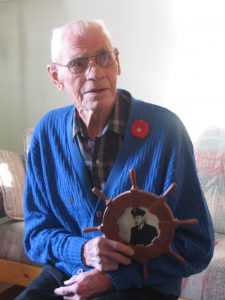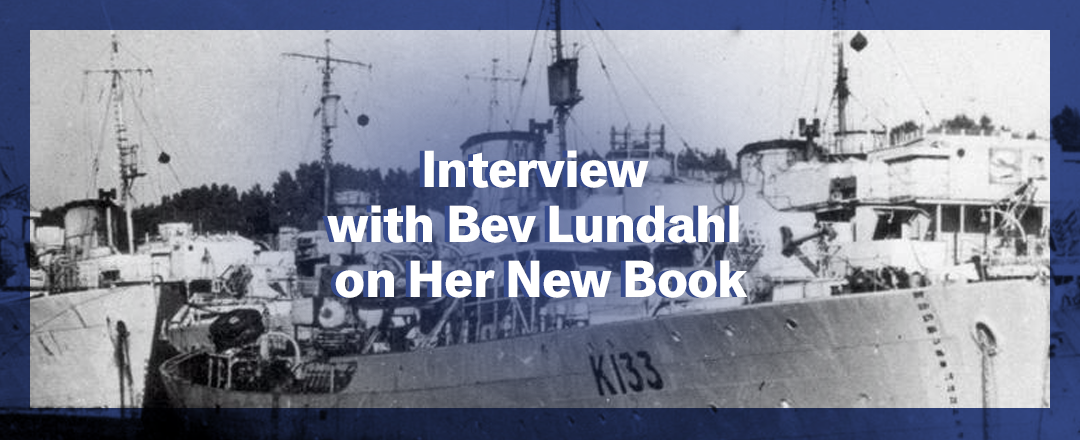
Genealogy has led Bev Lundahl down obscure trails that have lured her into hidden places and exposed forgotten slivers of Canadian history. Based on her late father’s experiences in the Royal Canadian Navy during the Second World War, The Thunderbird, the Quesnel & the Sea illustrates Canada’s challenges in its relations with Indigenous peoples. Her first book, Entangled Roots, the Mystery of Peterborough’s Headless Corpse (YNWP 2014) shares another family story that delves into Canada’s struggles with class and race in 19th-century Ontario.
What inspired you to write this book?
 I didn’t start out to write a book. When I looked at my dad, Len Lundahl’s war photo album 15 years ago I noticed the thunderbird mascot in the official photo of the crew on the deck of HMCS Quesnel and I became instantly curious about its origin and history. The story kept getting bigger and eventually it became a book.
I didn’t start out to write a book. When I looked at my dad, Len Lundahl’s war photo album 15 years ago I noticed the thunderbird mascot in the official photo of the crew on the deck of HMCS Quesnel and I became instantly curious about its origin and history. The story kept getting bigger and eventually it became a book.
Can you tell us exactly what a Thunderbird is, as well as what it means to both the First Nations and the Canadian seamen it became the mascot for?
To the crew on the Quesnel the thunderbird identified their ship as a west coast ship and was also looked upon as a lucky charm or protection during The Battle of the Atlantic. To the relatives of the man buried by the thunderbird who were of the Namgis clan of the Kwakwaka’wakw First Nation it was a grave marker and it represented the clan’s origin story and the family crest. A thunderbird has many different stories with Indigenous people across Canada and I don’t know all of them.
Can you tell us a little more about how sailors of the HMS Quesnel came to abscond with the Thunderbird?
The Quesnel made an unscheduled stop in 1942 at Alert Bay during a storm. A group of them went on land that night and when they came back on board they had this grave marker with them. It is possible that they didn’t know it was a grave marker. It was dark, the weather was bad and they were out drinking. However they knew it didn’t belong to them.
How much research went into telling the story of the Thunderbird?
I began the research in 2004 and finished it in 2017. During that time I had extensive correspondence and telephone conversations with Stan Noble, Jim Silvester and Frank Hewlko, A.J. Jeffires, Bob Holland and Cliff Burns who were veterans of the Quesnel – and my dad. I went to Alert Bay 3 times, the last time in 2017. That time I also met with relatives of the man buried by the thunderbird – Greta Picard at Ucluelet, Daisy Sewid-Smith at Campbell River and Trudy Tate at Victoria as well as Evelyn Dyck at Alert Bay. In 2017 I also went to Halifax and met with Navy personnel of HMCS Sackville the last corvette from the Second World War – Captain Jim Reddy and editor of Action Stations! magazine, Pat Jessup.
What was the most surprising thing you learned during your research?
The most surprising thing I learned was the story of the Kwakwaka’wakw Nation in B.C. – learning about the people there. And the conditions aboard these tiny corvettes that fought in the Battle of the Atlantic. And was very surprised to learn how many ships were sunk by German subs in the St. Lawrence River. HMCS Quesnel defended Canada on both coasts. I was not totally aware of how close the war came to Canada.

Len Lundahl
What advice would you give to students wanting to do their own research on veterans or stories of the Second World War?
I would suggest they look for war veterans in their community or the children and grandchildren of veterans. They can do this by contacting the Legion in their community or visiting veterans’ wards in nursing homes. Get them to tell their stories if they are willing. Talk to their oldest relatives about their experience during that time whether they were in the war or part of the home guard. Also visit HMCS Sackville in Halifax harbour to learn about the ships they served on. War museums are another source.
What efforts were made to find and return the Thunderbird after the war or compensate the First Nations for their loss?
The Quesnel veterans and I made a considerable effort to try and find and return the thunderbird. I published several articles on-line about it and we also contacted government sources. In the past year the Federal government has made some initiatives to make compensation for it.
Is there any additional reading you would suggest for teachers and students interested in Canadian History?
My first book Entangled Roots, the Mystery of Peterborough’s Headless Corpse is another research mystery that illustrates race and class relations in 19th c. Ontario. Both my books show how family history research can often reveal a remote connection with First Nations that we may have been unaware of. Since both books are research mysteries they also in the course of reading them show students how to do their own research using primary sources as well as oral history.
Stayed tuned for more on this story with an interview with HMS Quesnel vet Stan Noble in our Fall 2019 brochure!

